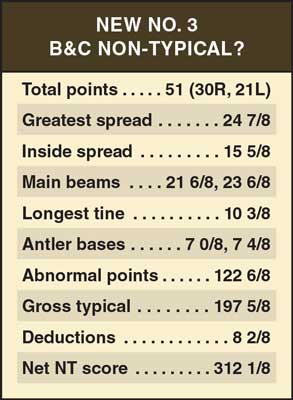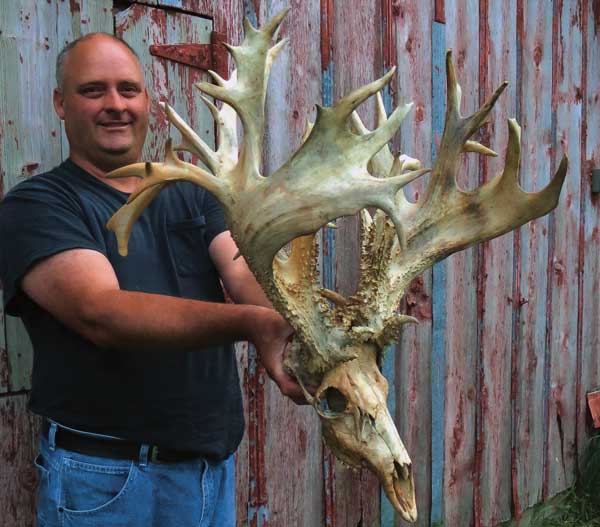While every Boone & Crockett buck is a special trophy, the loftiest benchmark—300 net inches—is so rare as to seem unreal. Only a handful of wild non-typicals have been certified at that score.
As featured with exclusive coverage in our October issue, Indiana just joined B&C’s unofficial “300 Club,” thanks to the 305 7/8-inch giant Tim Beck shot there last gun season. That brings the number of states with a legitimate 300-incher to their credit to five. In addition to Indiana, Ohio, Illinois, Missouri and Iowa have hit that mark, each with a single deer.
Conspicuously absent from this list is Kansas. The Sunflower State is legendary for its non-typicals, and rightly so. But officially, the state record is the 280 4/8-incher rifleman Joseph Waters shot back in 1987.
As huge as that buck is, the giant shown here is even bigger. Much bigger. In fact, based on the net entry score of 312 1/8, as calculated in early September by veteran measurer Dave Boland, this palmated beast finally pushes Kansas into B&C’s unofficial “300 Club.” At that score, this is potentially the No. 3 non-typical in whitetail history. What’s more, Dave came up with 51 points of an inch or more in length, making this the world’s first-ever true “50-pointer.”
In the Beginning
This buck’s story actually started in 2008, and it involves a man named Jim. (His last name will, at his request, remain anonymous—as will the exact location, though we can say it’s in northeastern Kansas.)
Jim’s an avid shed hunter, and that spring he came across a 120-inch matched set from a buck he didn’t know. Despite the antlers’ mass, they looked to be from a young deer. So Jim felt the buck had a lot of potential.
However, the shed hunter didn’t think a lot more about the deer until summer 2011. That’s when a giant, palmated buck suddenly appeared on an anonymous neighbor’s scouting camera. After Jim put two and two together, he realized this buck was likely the same one whose sheds he’d found back in 2008.
When deer season rolled around, the giant was nowhere to be seen. But then, in early 2012, as Jim was out looking for sheds, he found both fresh sides from the buck. Jim was walking a hedgerow at the time, and the huge antlers were lying merely 20 yards apart.
The shed hunter was excited to find them—and who wouldn’t be? The drops had a net score of 220 0/8 inches — with no spread! What’s more, when Jim got home and compared these massive sheds to the set he’d found three years earlier, he had no doubt they’d been grown by the same buck.
As summer 2012 arrived, the giant again started showing himself on the neighbor’s trail camera. Amazingly, his velvet rack now looked even bigger!
While the summer of 2012 brought Kansas some of the hottest, driest weather on record for that part of the U.S., this special deer still somehow was growing one of the largest racks ever seen. So Jim naturally was excited about what fall would bring. But not long after the monster started to show up on trail cameras, the photos stopped. The great whitetail simply vanished.
Jim naturally hoped the buck would return, but as time went on, it became clear something had happened. Jim recalled a rumor that some disease spread by gnats had been killing off huge numbers of deer across the country, and that this was related to the drought. (It was epizootic hemorrhagic disease, or EHD.) Curious to know if this might explain the buck’s disappearance, last Sept. 20 Jim set out on foot to investigate a nearby creek bottom the giant had been living in.
An avid trapper, Jim knows this creek bottom like the back of his hand. As soon as he entered the bottom, he started seeing the ugly evidence of EHD.
 “I had no idea we had so many dead deer,” he says. “As I was walking the creek, it seemed like every 100 yards I found a dead doe. After several dead does, I came upon a small buck, then more does.”
“I had no idea we had so many dead deer,” he says. “As I was walking the creek, it seemed like every 100 yards I found a dead doe. After several dead does, I came upon a small buck, then more does.”
By the time Jim had covered a little over a half-mile of the creek bottom on foot, he’d discovered nearly a dozen dead whitetails. Then came the moment that changed his life forever. Lying dead at the base of the creek’s south bank was the huge, palmated buck.
“I could hardly hold my composure as I stared at the freak of a lifetime,” Jim remembers. “It really felt like a dream. I just sat there and admired the giant. The smell of the dead deer was overwhelming, but I really didn’t care.”
A Kansas Department of Wildlife & Parks law enforcement officer provided Jim with what’s referred to as a “salvage” tag. This tag allowed him to legally obtain and keep the incredible rack.
Dave Boland is among the world’s most experienced B&C measurers, and he’s taped some of the top bucks of all time. While it’s undeniable his entry score could be amended by the organization (which presumably will call the rack in for panel judging in 2016), the fact Dave came up with a net score well above 300 gives us reason to think Jim’s buck is likely to remain a member of that elite group.
If this awesome deer had been shot by a hunter instead of being struck down by EHD, it appears he’d be the highest-scoring whitetail of all time. The only non-typicals verified by B&C as larger are the 333 7/8-inch Missouri Monarch and Ohio’s 328 2/8-inch “Hole in the Horn” buck, and both of those were found dead. (Although some captive bucks have scored higher than these deer, B&C doesn’t accept whitetails or other big game taken inside high fences.)
whitetail of all time. The only non-typicals verified by B&C as larger are the 333 7/8-inch Missouri Monarch and Ohio’s 328 2/8-inch “Hole in the Horn” buck, and both of those were found dead. (Although some captive bucks have scored higher than these deer, B&C doesn’t accept whitetails or other big game taken inside high fences.)
The current No. 3 B&C buck, and the biggest ever taken by a hunter, is Tony Lovstuen’s 2003 Iowa giant, which nets 307 5/8. (Indiana’s Beck buck has been entered at 305 7/8, pending panel judging. The only other hunter-shot buck certified at over 300 net by B&C is Jerry Bryant’s 304 3/8-incher, which was taken by crossbow in Illinois in 2001.)
EHD hit whitetails hard in many areas last year, as severe drought struck much of the Great Plains and Midwest. While as of this writing there haven’t been nearly as many cases reported in 2013, every year some deer succumb to this gnat-borne virus. And as in the case of Jim’s giant, the largest bucks often are among the dead. At least this particular EHD victim was found and documented, so the world can appreciate what a special deer he was.
For Your Information
The editors thank Wayne Cox for his help in securing details on Jim’s buck. For more about the Beck buck, as well as to read recent field reports on deer activity everywhere, check out NAW’s Deer of the Day. To follow the adventures of Mike Charowhas, “The Antler Collector,” visit him on Facebook.
Read more: North American Whitetail





